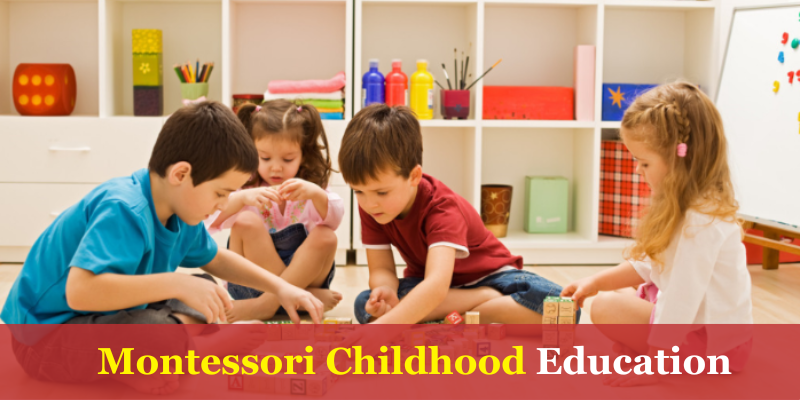
Educating young children is always fun, right? It is equally important to understand them and their learning capabilities before starting their formal education. Montessori teaching methods are non-traditional, involving lively, interactive teaching sessions using various visual aids and tools instead of a traditional blackboard approach. The basic idea is to engage children in what they are learning and prepare them with fun-filled, play-way activities that help bring out their personalities. Rather than forcing language, math, or any other subject on them, the goal is to make learning an enjoyable experience through exciting activities and storytelling sessions. This teaching method, not new in India, benefits the children and their learning process.
Montessori preschool education system
The Montessori education is a scientific-based approach that focuses on fostering independence, freedom of learning under limits, and respect for a natural development of child. Maria Montessori, a physician and educator in italy, developed it in the early 20th century. This educational method is grounded in five basi guiding principles: respecting the child, the absorbent mind, the sensitive periods, the prepared environment, and auto-education or self-education. It emphasizes in creating a cohesive and scientific environment that supports self-learning and allows and encourages children to learn at their own pace. The Montessori approach is reality-oriented and utilizes specific materials and educational tools to cater to the inner needs of the children, providing a unique and effective way of nurturing their overall development.
Methods of Montessori education
The Montessori method of teaching is deeply rooted in the principle of respecting the child above all else, a notion that was quite unconventional and impossible in the early twentieth century. Dr. Maria Montessori firmly believed in showing the utmost respect towards children, particularly by refraining from interrupting their concentration and listening levels. The Montessori Curriculum encompasses five fundamental areas of study: Practical Life, Sensorial, Mathematics, Language, and Culture. Furthermore, the method is characterized by the four essential pillars—sensitive periods, a prepared conductive environment, sensory education, and spontaneous activity through *repetition—all of which play a pivotal role in guiding the teaching practices and make it successful.
In a Montessori setting, educators act as mere mentors, skillfully guiding students through natural social interactions and nurturing collaborative efforts. The role of the teacher here is to meticulously craft and prepare the learning environment, fostering an atmosphere which is conducive to optimal learning.
Montessori Teaching Techniques
Montessori Toy
A Montessori toy is one that stimulates learning by encouraging kids to experiment with it. It should be something that they can hold and touch, as learning to manipulate objects is a key to helping children develop their fine motor skills.
What are Montessori teaching activities?
Children learn most effectively by actively exploring new ideas. In Montessori schools, students are encouraged to physically engage with learning rather than just sitting and listening to what the teacher says. They can freely move around the classroom according to their wish and take part in hands-on activities, giving them full control over their learning experience.
Hands-on tasks are a crucial and interesting part of the Montessori approach. These activities enable students to use their hands to interact with their learning environment, keeping them engaged and focused to what they are doing. Some examples of hands-on activities include pouring and scooping, washing windows, and creating anything with paper and glue.
Pouring and Scooping
Pouring and scooping are activities that allow children to experience a new thing. This activity can be implemented in various subjects like math, gardening, counting, arranging, and more. Within these activities, teachers let students choose how to use the child-friendly materials, giving them autonomy over their learning process. Pouring and scooping activities help children develop fine motor skills at an early age. These tasks additionally provide valuable sensory experiences, which are important to childhood development as a whole.
Washing windows
When students learn to wash a window or any other practical chore, they are allowed to use their hands to engage with the environment and practice new skills. Washing the window can involve students using a nice spray bottle to distribute water across the window surface, letting them practice using big arm movements and clamping the spray mechanism simultaneously. These activities will help children in developing their fine motor skills naturally and teach them responsible ways to interact with their family and get used to their home environments.
Glue a paper
Gluing paper is an activity that can be used to teach children the various learning concepts. Montessori & child care teachers use different methods for gluing based on the child’s age and motor skills of their students, some students may use popsicle sticks or any tool to apply glue to a page, while others may practice squeezing glue from a bottle. These activities can help students enhance their fine motor skills and express their creativity.
Advantages of Montessori teaching methods
The Montessori preschool education methods are widely welcomed and receive tremendous support worldwide. Children follow a stress-free approach to learning, emphasizing the importance of concentration and independent work. The early stages of life should not be about judging capabilities; each child is unique and needs time to understand and showcase their abilities. Therefore, it is best advised to join a Diploma in Montessori and learn the Montessori methods before preparing young children for their educational journey.